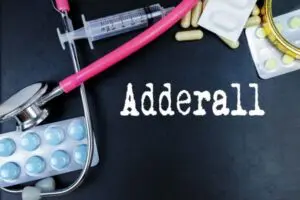Meth vs Adderall – Are They the Same?

Amphetamines are a frequently abused class of drugs, listed by the World Health Organization as the second most frequently abused drug. But, while amphetamines are frequently abused for illicit and recreational purposes, there are many different types of amphetamines on the market. Two of the most common include methamphetamine, an illegal street drug and Adderall, a prescription medication most commonly used to treat ADHD.
While methamphetamine and Adderall come from very different places, both qualify as amphetamines, with a stimulating effect on the body.
Both create similar effects and side-effects, and both present a high risk of addiction and health problems. But, are they the same? In this article, we’ll explore the differences between methamphetamine and Adderall, alongside how addiction works for each so you can better understand the dangers of abusing either drug.
What Are Amphetamines?
Amphetamines are a drug class, composed of two amphetamine, salts levoamphetamine and dextroamphetamine. These drugs typically impact the body in several ways, improving performance, boosting cognitive performance, causing euphoria, and making the user feel energetic. In prescription doses, these effects are very mild but in recreational doses are typically significantly stronger. Higher doses also cause side-effects such as cognitive and muscle breakdown, chemical dependence leading to addiction, and damage to the gastrointestinal tract.
Amphetamines primarily act by interacting with the norepinephrine and dopamine neurotransmitters and receptors in the brain. This causes increased euphoria and increases in energy and stamina. However, it also changes how the brain produces neurotransmitters, resulting in long-term problems with emotional blunting, “down” periods after recreational use, crashes, and likely symptoms of depression and anxiety during larger-volume usage. Amphetamines also affect cognition and personality by impacting sleep, sometimes keeping individuals up for days at a time.
What is Methamphetamine?
Methamphetamine is an amphetamine-class drug most commonly used as a recreational drug. Methamphetamine is composed of an equal mixture of dextroamphetamine and levoamphetamine. Dextroamphetamine is the stronger of the two drugs and is typically illegal to purchase or get with a prescription. This drug is, however, typically easy to synthesize, often using readily available ingredients. Levoamphetamine is the weaker of the two amphetamine amines and is typically used as a nasal contestant found in over-the-counter medications such as Vicks, Nyquil or Robitussin. Taken orally, Levoamphetamine has no potential for euphoria. However, in high dosage injection, it does.
What is Adderall?

Adderall is a drug composed of 25% levoamphetamine and 75% dextroamphetamine salts. Amphetamine salts isolate the neutral salts in the amines. Here, Adderall is made up of a combination of neutral salts and active stimulants, reducing the overall active ingredients per weight of amphetamine drug. Most amphetamines also include a range of filler ingredients such as cellulose to aid with dosing and pill-size.
So, What’s the Difference?
Adderall and Methamphetamine are largely made up of the same chemicals. However, the ratios and the active ingredients are intrinsically different. For example, Adderall appears to have more of the euphoria-inducing dextroamphetamine, but with the dextroamphetamine content consisting of 50% dextroamphetamine sulfate salts, the quantity of euphoria-inducing ingredient is lower.
Another consideration is production. Adderall is typically produced in a controlled lab setting with high standards of quality, chemical purity, and chemical measuring. Any Adderall pill put onto the market will contain active ingredients of precisely 25% Dextroamphetamine Saccharate, 25% Amphetamine Aspartate Monohydrate, 25% Dextroamphetamine Sulfate, and 25% Amphetamine Sulfate alongside various cellulite and fillers. Doses are precise, and a 5mg pill will always include 5mg of amphetamine. Methamphetamine is almost never produced in high-quality medically-controlled settings. Instead, it’s illegal to produce, leading to lower standards of production, lower chemical purity, and lower chemical standards in terms of active ingredient ratios. This means that a dose of methamphetamine could be more or less active ingredient than expected. It could also contain elements of other trace chemicals, and sometimes toxic ones. With no standards for production, it’s easier to overdose, induce chemical toxicity, or otherwise experience problems while taking methamphetamine.
Finally, methamphetamine may not be produced in sterile lab conditions. It may be contaminated with bacteria or other health-threatening chemicals. This can be problematic, especially to an already-weakened immune system.
So, is Adderall Safe?
Adderall is perfectly safe when taken according to a prescription, with a risk management strategy in place. At prescription doses, Adderall presents very little risk of addiction and is very unlikely to cause major side-effects or health problems. Some individuals are higher-risk and should consult their doctor or seek out a risk-mitigation strategy to prevent addiction.
However, Adderall is also one of the most abused amphetamine drugs. Millions of individuals take Adderall without a prescription for reasons ranging from cognitive and physical performance boosts to use as a party drug for euphoria and energy. In these large doses, Adderall is every bit as dangerous as methamphetamine, simply because of the massive effects it has on the neurotransmitter system. Here, Adderall can contribute to prolonged wakefulness, chemical dependence and eventually addiction, cravings, emotional blunting when off the drug, depression and anxiety, muscle deterioration, cognitive deterioration, and possible side-effects such as paranoia and even hallucinations.
In short, amphetamine drugs can be safe to use in low doses, as prescribed by a doctor. They are never safe to use in larger doses without medical supervision.
Amphetamine Addiction

Amphetamine addiction manifests quickly, typically over the course of a few weeks of regular usage, and will show the same symptoms across most types of the drug. Identifying amphetamine usage is typically the first step. Here, you can look for increases in energy, confidence, manic behavior, paranoia, and agitation. Individuals on high doses of Adderall will typically act sick, with symptoms like sweating, shaking and tremors, insomnia, and mood-swings.
Recognizing amphetamine addiction over time also relies on recognizing symptoms. Most amphetamine users will show a pattern of mood highs and lows, having massive amounts of energy some days and none at all on others. These symptoms should be side-by-side weight loss, insomnia, paranoia, increasing psychosis, depression, motor skill impairment, possible hallucinations or delusions, jerky movements, and emotional and sensory blunting (inability to feel).
Most importantly, if you know a loved one is using amphetamines outside of a prescription, chances are, they need help. Even an otherwise safe drug like Adderall can be extremely dangerous when abused. Large doses of amphetamines are always damaging to physical and mental health.
Getting Help for Amphetamine Addiction
If you or a loved one is abusing amphetamines, there is help. Amphetamines are highly addictive and tolerance inducing. Many people find that even detoxing on their own is extremely difficult and even dangerous, with individuals experiencing harsh withdrawal symptoms for up to a month after taking a final dose. The longer and more heavily an individual has been using, the worse these symptoms will be.
Getting professional help in the form of medically supervised drug detox, therapy, and counseling will help you or your loved one to recover from addiction and move back to your life. Here, a rehab center will offer medical detox to ensure you safely detox from the drug. Once withdrawal symptoms are over, individuals are moved into rehab, where they learn coping mechanisms, new behaviors that don’t include drug use, life skills, and how to live a happy life without substance abuse. These programs can range from several weeks to several months or even a year and should almost always include follow-up care such as ongoing therapy or self-help groups, because the intent is to create an ongoing process of recovery and to provide ongoing motivation to change.
Amphetamine addiction is dangerous, damaging to health, and often damaging to an individual’s ability to live a happy life. If you or a loved one is struggling, there is help.

